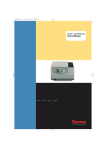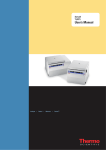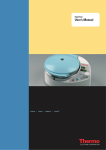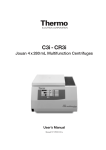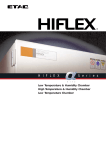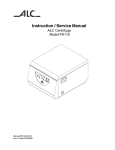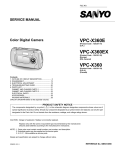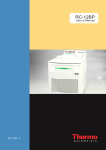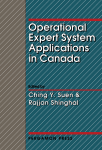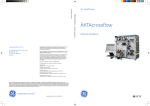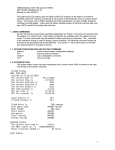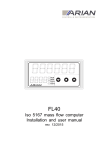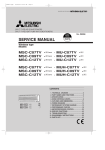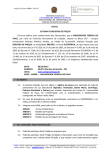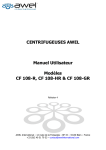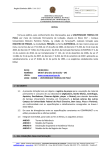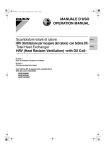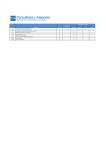Download User`s Manual
Transcript
IEC CL40 - FL40 Series User’s Manual Analyze • Detect • Measure • ControlTM IEC CL40 - FL40 Series User’s Manual CL40 - FL40 Series Carefully read this manual before operating your instrument. Information contained in this document is the property of Thermo Electron Corporation; it may not be duplicated or distribuited without the owner’s authorization. The validity of the guarantee is subject to the observation of the instructions and precautions described in this document. Preface MANUAL NUMBER REV ECR/ECN DATE DESCRIPTION a 11290088 03/06 Initial release Thermo Electron Corporation BY CL40 - FL40 i Packing List 11210922 11210923 11210924 CL40, CL40 CL40 230V 50/60 Hz 120V 60 Hz 100V 50/60 Hz 11210940 11210941 11210942 FL40 FL40 FL40 230V 50/60 Hz 120V 60 Hz 100V 50/60 Hz 11210926 11210927 11210928 11210929 CL40R CL40R CL40R CL40R 230V 50/60 Hz 120V 60 Hz 100V 50 Hz 100V 60 Hz 11210943 11210944 11210945 11210946 FL40R FL40R FL40R FL40R 230V 50/60 Hz 120V 60 Hz 100V 50 Hz 100V 60 Hz Item number Quantity Check Centrifuge User manual 1 CE Declaration of compliance 1 Manual lid opening instructions 1 Imbalance protection instructions 1 64227001 Mains cord 1 26227005 Toolbox: 26339005 • Rotor removal tool 1 85241084 • Emergency unlooking tool 1 86000897 • 12 and 13 mm wrench 1 25055501 • 21 mm wrench 1 11290088 For missing parts call your nearest Thermo representative ii CL40 - FL40 Thermo Electron Corporation WEEE Compliance Great Britain WEEE Compliance. This products is required to comply with the European Union’s Waste Electrical & Electronic Equipment (WEEE) Directive 2002/96EC. It is marked with the following symbol. Thermo Electron has contracted with one or more recycling/disposal companies in each EU Member State, and this products should be disposed of or recycling through them. Further information on Thermo Electron’s compliance with these Directives, the recyclers in your country, and information on Thermo Electron products which may assist the detection of substances subject to the RoHS Directive are available at www.thermo.com/WEEERoHS Deutschland WEEE Konformittät. Dieses Produkt muss die EU Waste Electrical & Electronic Equipment (WEEE) Richtlinie 2002/96ECerfüllen. Das Produkt ist durch folgendes Symbol gekennzeichnet. Thermo Electron hat Vereinbarungen getroffen mit Verwertungs-/Entsorgungsanlagen in allen EU-Mitgliederstaaten und dieses Produkt muss durch diese Firmen widerverwetet oder entsorgt werden. Mehr Informationen über die Einhaltung dieser Anweisungen durch Thermo Electron, die Verwerter und Hinweise die Ihnen nützlich sein können, die Thermo Electron Produkte zu identizfizieren, die unter diese RoHS Anweisung fallen, finden Sie unter www.thermo.com/WEEERoHS Italia Conformità WEEE. Questo prodotto deve rispondere alla direttiva dell’Unione Europea 2002/96EC in merito ai Rifiuti degli Apparecchi Elettrici ed Elettronici (WEEE). È marcato col seguente simbolo. Thermo Electron ha stipulato contratti con una o diverse società di riciclaggio/smaltimento in ognuno degli Stati Membri Europei. Questo prodotto verrà smaltito o riciclato tramite queste medesime. Ulteriori informazioni sulla conformità di Thermo Electron con queste Direttive, l’elenco delle ditte di riciclaggio nel Vostro paese e informazioni sui prodotti Thermo che possono essere utili alla rilevazione di sostanze soggette alla Direttiva RoHS sono disponibili sul sito www.thermo.com/WEEERoHS Espana WEEE. Este producto requiere cumplir con la Directiva 2002/96EC WEEE (residuos de quipos electricos y electronicos). Este producto esta marcado con el simbolo WEEE, como se describe. En cada Estado Miembro de la Union Europea (EU), Thermo Electron ha contratado con diversas companias para disponer y/o re-ciclar los residuos de equipos electricos y electronicos. Existe information adictional acerca de la conformidad de Thermo Electron con esta Directiva, incluyendo los nombres de las diversas companias autorizadas para disponer/recyclar nuestros productos. Adicionalmente suministramos informacion acerca Thermo Electron Corporation CL40 - FL40 iii WEEE Compliance de los productos de Thermo Electron que puedes asistir en la deteccion de substancian mensionades en la directiva RoHS, explicado en www.thermo.com/WEEERoHS France iv CL40 - FL40 Conformité WEEE. Ce produit doit être conforme à la directive européenne (2002/96EC) des Déchets d’Equipements Electriques et Electroniques (DEEE). Il est merqué par le symbole suivant. Thermo Electron s’est associé avec une ou plusieurs compagnies de recyclage dans chaque état membre de l’union européenne et ce produit devrait être collecté ou recyclé par celles-ci. Davantage d’informations sur la conformité de Thermo Electron à ces directives, les recycleurs dans votre pays et les informations sur les produits Thermo Electron qui peuvent aider le détection des substances sujettes à la directive RoHS sont disponibles sur www.thermo.com/WEEERoHS Thermo Electron Corporation Declaration of compliance Declaration de conformite We, Thermo Electron Industries S.A.S., Z.I. d’Aze Bellitourne 53200 CHATEAU-GONTIER, France, declare that the instrument defined here below complies with the following European directives: Declaration of compliance Nous, Thermo Electron Industries S.A.S., Z.I. d’Aze Bellitourne 53200 CHATEAU-GONTIER, France, déclarons que le matériel désigné ciaprès est conforme aux directives européennes suivantes: Konformitätserklärung Wir, Thermo Electron Industries S.A.S. , Z.I. d'Aze Bellitourne 53200, CHATEAU-GONTIER, France, erklären dass das hier beschriebene Gerät sich in Übereinstimmung mit folgenden europäischen Richtlinien befindet: Declaración de conformidad Nostros, Thermo Electron Industries S.A.S., Z.I. d’Aze Bellitourne 53200 CHATEAU-GONTIER, France, declaramos que el instrumento bajo descrito está fabricado según las especificaciones establecidas por las siguientes normas europeas: Declaraçao de conformidade Nós, Thermo Electron Industries S.A.S., Z.I. d’Aze Bellitourne 53200 CHATEAU-GONTIER, France, declaramos que o instrumento aqui apresentado está de acordo com as normas européias abaixo listadas: Dichiarazione di conformità Noi, Thermo Electron Industries S.A.S., Z.I. d’Aze Bellitourne 53200 CHATEAU-GONTIER, France, dichiariamo che lo strumento sotto descritto è conforme alle seguenti Direttive europee: • Machinery: 98 / 37 / CEE • Low voltage: 72 / 23 / CEE - 93 / 68 CEE • EMC: 89 / 336 CEE - 92 / 31 CEE - 93 / 68 CEE • Safety standard: EN 61010-1 - EN 61010-2-020 Château-Gontier, 28th June 2005 Managing Director Christian Galiana Thermo Electron Corporation CL40 - FL40 v Guarantee Terms Thermo guarantees that this unit is free from defects in materials and workmanship when it leaves the factory, and will replace or repair the unit if it proves defective in normal use or during service for a period of ONE YEAR from the delivery. This guarantee is invalid if the unit is incorrectly used, poorly serviced or neglected, mis-used or accidentally damaged. There is no explicit guarantee other than as stated above. vi CL40 - FL40 Thermo Electron Corporation For further information, assistance or service United States of America Tel.: +1 800 522 77 46 Fax: +1 866 984 37 66 Canada or Latin America Tel.: +1 800 522 77 46 Fax: +1 866 984 37 66 China (Shanghai) Tel.: +86 21 68 65 45 88 Fax: +86 21 6445 7907, +86 21 6445 7830 India (Mumbai) Tel.: +91 22 5542 9494 Fax: +91 22 5542 9495 Japan Tel.: +81 454 53 9220 Fax:+ 81 454 53 9222 Other Asia-Pacific Countries Tel.: +852 28 85 46 13 Austria Tel.: +43 (1) 80 14 00 France Tel.: +33 1 69 18 77 77 +33 2 28 03 20 00 Belgium Tel.: +32 24 82 30 30 Italy Tel.: +39 02 95 05 91 Netherlands Tel.: +31 7 65 71 44 40 Russia/Cis Tel.: +7 09 52 25 11 15 Spain and Portugal Tel.: +34 9 32 23 31 54 Switzerland Tel.: +41 (1) 4 54 12 12 United Kingdom and Ireland Tel.: +44 87 06 09 92 03 Other Europe, Middle East, or Africa Tel.: +49 61 8490 6940 Tel.: +33 2 2803 2000 In Other Countries: Contact your local THERMO products distributor or agent. E-mail Technical Service Representative for products at: [email protected] Visit our web site at: www.thermo.com Germany Tel.: +49 61 84 90 69 40 Fax: +49 61 03 40 81 012 Finland Tel.: +35 89 32 91 00 Thermo Electron Corporation CL40 - FL40 vii Contents viii CL40 - FL40 Chapter 1 Use and Function........................................................................................1-1 User Manual......................................................................................1-1 Warning Symbols ..............................................................................1-1 Description ......................................................................................1-1 Refrigeration and Heating Systems....................................................1-2 Drive System ....................................................................................1-3 Safety Interlock System ....................................................................1-3 Imbalance Detection System ............................................................1-3 Relative Centrifugal Force ................................................................1-4 Chapter 2 Specifications ............................................................................................2-1 Dimensions and Weight ....................................................................2-1 Centrifugation Specifications ............................................................2-1 Electrical Specifications ....................................................................2-2 Chapter 3 Installation ..................................................................................................3-1 Environmental Conditions ................................................................3-1 Unpacking ........................................................................................3-1 Positioning ........................................................................................3-2 Mains Supply ....................................................................................3-2 Lid Opening and Rotor Checking ....................................................3-3 Manual Lid unlocking Procedure ......................................................3-3 Performance and Accessories ............................................................3-5 M4 Swing-out Rotor - Cat. N°: 11175338 ......................................3-5 Biocontainement Accessories ............................................................3-6 QG2.5 Swing-out Rotor - Cat. N°: 11175382..................................3-8 Angle Rotors ....................................................................................3-8 Glassware ........................................................................................3-10 Chapter 4 Instructions for Use....................................................................................4-1 Controls and Indicators ....................................................................4-1 Display Screens ................................................................................4-2 Control Panel Functions ..................................................................4-3 Control Panel Indicators ..................................................................4-4 Description of Certain Events with Respect to the Control System ..4-5 Preparing the First Run of the Day ..................................................4-7 Sample Loading ................................................................................4-7 Thermo Electron Corporation Contents Thermo Electron Corporation Chapter 5 Hazards, Precautions and Limitations of Use ......................................5-1 IEC 1010-2-020................................................................................5-1 Cautions............................................................................................5-1 Speed Control ..................................................................................5-2 Operational Limitations ....................................................................5-2 Aerosol Risks ....................................................................................5-2 Chapter 6 Service and Maintenance ........................................................................6-1 Periodic Cleaning ..............................................................................6-1 Contamination Hazards ....................................................................6-1 Disinfection ......................................................................................6-2 Radioactive Decontamination ..........................................................6-2 Power Supply Circuit Breaker............................................................6-3 Rotor Removal ..................................................................................6-3 Trunnion Lubrication........................................................................6-3 Chemical Compatibility Table for Rotors, Tubes and Accessories......6-4 Chapter 7 Disposal of Product....................................................................................7-1 CL40 - FL40 ix Chapter 1 User Manual Use and Function The user manual is part of the centrifuge, and contains important information for your safety and for the best use of the equipment Always keep the manual close to the appliance and in a safe place, so that it is always available. Thermo strongly recommends that all users read this manual carefully. Warning Symbols The following symbols are provided to help the operator take advantage of the protection afforded by the equipment and to warn of potential danger. On the main switch, allows centrifuge to operate. ▲ On the main switch, disconnects the centrifuge from the main power supply. ▲ Only authorized personnel can touch the parts close to this symbol and, in any case, only after switching off the main power supply. Coming in contact with high voltages could cause severe injuries. ▲ In this manual, this symbol means that you will find important information for safety, which if unobserved could result in damage to the appliance and/or harm to the operator. ▲ In this manual, this symbol means that you will find important information about minimizing biological risk: if unobserved the result could be harm to the operator. ▲ Description The CL40 and FL40 centrifuges are designed for laboratory use. They will separate the components of fluids into layers of varying density by subjecting them to high forces. Centrifugal force provided by the centrifuge can also be used to drive solvents and low molecular weight solutes through the membrane of a filtering device. Retained macrosolutes will therefore be found above the membrane. Relative Centrifugal Force (RCF) generated by a rotor is directly Thermo Electron Corporation CL40 - FL40 1-1 Chapter 1 Use and Function proportional to its sedimentation useful radius and to the value of its speed squared. A control system permits the user, through an extremely intuitive control panel, to set and control the speed, the g-force, the temperature (on the thermostated and refrigerated versions) and the run time, as well as to view different messages and warnings. Refrigeration and Heating Systems The CL40 and FL40 are ventilated unit. A permanent air circulation reduces the heat level in the bowl. However the temperature in the bowl can reach 10 °C above the ambient temperature after hours of continuous operation. The CL40R and FL40R are equipped with a powerful refrigeration system that allows samples to be processed at low temperature. The refrigerant, R134a, is free of CFC (Chloro-Fluoro-Carbons) in accordance with the Montreal Protocol directions for preservation of the ozone layer in the atmosphere. The actual temperature in the bowl is continuously displayed on the front panel of the centrifuge. Under certain conditions (high speed, long duration runs) the sample temperature can be higher than the bowl temperature on the display. In this case, the user may compensate manually after empirical determination of the temperature differential. Condensation drain on refrigerated units The lid should remain closed when the refrigeration system is in use to avoid condensation. The centrifuge has a rubber hose that allows condensation to be drained from the bowl. The drain hose exits at the back of the machine. Near the drain hose you can find the following label: To remove condensation, please follow this procedure: 1-2 CL40 - FL40 • Switch off the centrifuge and disconnect the power. • Put a small basin under the hose. • Unplug the hose. Thermo Electron Corporation Chapter 1 Use and Function • Drain the centrifuge bowl. • Insert the plug back into the hose. Attention Do not remove the plug from the drain hose during centrifugation. ▲ Drive System A three phase brushless motor drives the rotating equipment. The rotor is contained in a sealed, armor plated centrifugation chamber. The brushless motor requires no maintenance. A control system ensures the correct drive speed, which is continuously monitored. Safety Interlock System The CL40 and FL40 centrifuge series are equipped with an interlock system that assures two basic safety features: • The run cannot be started if the lid is not correctly closed. • The centrifuge lid cannot be opened if the rotor is running. The centrifuge will not operate until the lid is closed and latched in place. The lid remains latched until the rotor stops spinning. The lid access lamp indicates when the rotor has stopped: consequently the handle on the right hand side of the centrifuge can be used to open the lid. If a power failure occurs, access to the samples in the centrifuge is possible via a manual lid opening procedure (see appropriate paragraph). For this operation a special tool (supplied with the centrifuge) is required. Bypass the interlock system only under emergency conditions as the rotor could still be rotating. Imbalance Detection System The CL40 and FL40 centrifuge series are equipped with a load imbalance detector. In case of excessive imbalance, the load imbalance indicator LED is illuminated and the brake is applied immediately. The rotor will be decelerated to rest in few seconds. As soon as the motor stops, open the centrifuge and redistribute the samples to produce an equal weight on diametrically opposite sides. If the message persists, despite your efforts to balance the load, call your Thermo Service representative. Thermo Electron Corporation CL40 - FL40 1-3 Chapter 1 Use and Function Note Imbalance tolerance depends upon the rotor in use. The centrifuge will tolerate 15 gr. of imbalance with the M4 rotor equipped with standard buckets. Carefully balance the sample load to avoid actuating the imbalance detection system. If the protection has not been removed from the imbalance detection device during installation, the centrifuge will consider this as an imbalance situation and will not operate. Relative Centrifugal Force Relative Centrifugal Force (RCF), at the circumference of a rotor and bucket combination, is directly proportional to the speed (r.p.m.) and radius of the rotor. Therefore, a greater r.p.m. and/or a larger radius produces a greater RCF and improved faster separation of substances. The centrifuge control system carries out and displays the results of all calculations related to speed, radius and RCF. Note : The value introduced for the radius can be adjusted to allow for position within the tube such as at a boundary. Maximum radii are quoted in the specifications tables. Use of improper radius will adjust the speed setting, automatically applying the wrong RCF. 1-4 CL40 - FL40 Thermo Electron Corporation Chapter 2 Specifications Dimensions and Weight CL40 FL40 CL40R FL40R Height - lid open (cm / in) 92/ 36.2 134/ 58.8 92/ 36.2 134/ 58.8 Height - lid closed (cm / in) 42/ 16.5 86/ 33.8 42/ 16.5 86/ 33.8 Width (cm / in) 58/ 22.8 58/ 22.8 85/ 33.5 58/ 22.8 Depth (cm / in) 66/ 26.0 66/ 26.0 66/ 26.0 66/ 26.0 Weight unpacked (kg / lb.) 80/176 95/209 106/233 115/253 Height (cm / in) 50/ 19.7 99/ 38.9 50/ 19.7 99/ 38.9 Width (cm / in) 70/ 27.6 68/ 26.7 97/ 38.2 68/ 26.7 Depth (cm / in) 67/ 26.4 78/ 30.7 67/ 26.4 78/ 30.7 Weight packed (kg / lb.) 91/201 120/264 116/256 145/319 Product Dimensions Packing Centrifugation Specifications CL40 Max capacity (4x750 mL) 3000 mL (4x750 mL) 3000 mL Fixed Angle (8x100 mL) (8x100 mL) 1200 kg/m3 1200 kg/m3 3.6 kg 3.6 kg Swing-out (M4) 4000 rpm 4500 rpm Swing-out (QG2.5) 5400 rpm 5400 rpm Fixed Angle 7800 rpm 8000 rpm Swing-out (M4) 3810 x g 4822 x g Swing-out (QG2.5) 4140 x g 4140 x g Fixed Angle 9862 x g 10375 x g < 66 dBA < 62 dBA Max load Max RCF CL40R-FL40R Swing-out Max density Max speed FL40 Max noise CL40 FL40 CL40R-FL40R Microprocessor control yes yes Programs (direct recall) 5 5 500 - 7800 500 - 8000 10 rpm at less than 1000 rpm 10 rpm at less than 1000 rpm 100 rpm at above 1000 rpm 100 rpm at above 1000 rpm ± 20 rpm (display) ± 20 rpm (display) Speed set/display Range Step Accuracy Thermo Electron Corporation CL40 - FL40 2-1 Chapter 2 Specifications CL40 RCF set/display Range FL40 CL40R-FL40R 20 - 9900 20 - 10400 10 x g at less than 1000 x g 10 x g at less than 1000 x g 100 x g at above 1000 x g 100 x g at above 1000 x g ± 20 x g (display) ± 20 x g (display) 30 s - 99 min + continuous 30 s - 99 min + continuous Temperature set/display - -9°C to +40°C -9°C to +60°C Acceleration rates 5 5 Braking rates 5 5 Drive system direct direct yes yes Step Accuracy Timer set/display Brushless induction motor Electrical specifications CL40 FL40 CL40R-FL40R Nominal operating voltage 230V 230 V ±10% 230 V ±10% 120V 120 V ±10% 120 V ±10% 1200 W 1500 W 3750 BTU / h 4435 BTU / h Power requirements (maximum) Heat output (maximum) 2-2 CL40 - FL40 Thermo Electron Corporation Chapter 3 Environmental Conditions Installation General conditions accepted for centrifuge transport and storage are: • Ambient temperature -20°C to +50°C. • Relative humidity up to 90%. General conditions accepted for operating the centrifuge safely are: Unpacking • Indoor use. • Temperature: 5 °C to 40 °C. • Maximum relative humidity of 85%. • Maximum altitude: 2000 m • Installation category: II • Polution degree: 2 Due to the weight of the machine, all lifting and transporting must be carried out using proper handling equipment (i.e. fork lift trolley) that complies with current regulations, and by people having undergone the necessary training. Thermo strongly recommends that all operators comply with the local laws and regulations on safety and health in the workplace. The machine must be supported from underneath. If it has to be transported without its pallet, for example on a staircase, professional handling assistance is required. ▲ Thermo Electron Corporation • Unpack the centrifuge, carefully removing any possible accessories and the material supplied for ordinary operations and maintenance. • Check the contents of the package using the packing list provided above. • Keep the packaging until the centrifuge has been tested and found fully functional. CL40 - FL40 3-1 Chapter 3 Installation Positioning The machine must be installed in a dust and corrosion free room. Leave a 30 cm / 12 in. space free on each side of and behind the machine for safety reasons, proper ventilation and maximum cooling performances. ▲ Benchtop Units Floor standing units Place the centrifuge on a bench top, which must be rigid, horizontal and sufficiently strong to support the centrifuge’s weight and small vibrations. Place the centrifuge on a horizontal floor. After proper positioning is defined, LOCK BOTH WHEELS by pushing with the foot on the wheel locks. ▲ Main Supply Check mains and frequency: they must correspond to the values shown on the instrument identification label. Cat N° Content Voltage Frequency Type Keypad control 11177560 CL40 11177563 CL40R 10 A single 11177566 FL40 + ground 11177569 FL40R 11177561 CL40 11177564 CL40R 11177567 FL40 11177570 FL40R + ground For your safety, check that mains wiring is effectively grounded. Thermo declines all responsibility for any damages due to nongrounding of the machine. ▲ Remember that in order to respect the electrical safety standards related to protection against indirect contact, the supply of power to the instrument must be via a power socket fitted with a protection device ensuring automatic cut-off in the case of an insulation fault. A supply fitted with a circuit breaker of the correct rating complies with this requirement. 3-2 CL40 - FL40 Thermo Electron Corporation Chapter 3 Installation Lid Opening and Rotor Checking Ensure that the centrifuge has been switched ON. Pull the handle on the centrifuge right side towards the front of the unit : the lid is automatically unlocked and opens. In the case of a mains power outage, opening of the lid is prevented by the lid lock safety device. It is recommended to wait for the mains power to be switched back on so that this safety device enables the lid to be unlocked (refer to 3.6 for manual lid opening). Carefully clean the inside of the centrifugation chamber removing any packing residues. In fact, due to air turbulence, solid particles accidentally left in the centrifugation chamber create excessive wear of the chamber itself and of the outer rotating equipment surface. ▲ To install the rotor: Manual Lid Unlocking Procedure • Check that the motor shaft and rotor are clean • Put the rotor on the motor shaft • Secure the rotor on the shaft by turning the hexagonal nut counterclockwise (with the supplied tool) • Verify that the rotor cannot be removed by trying to pull it (gently) off the shaft. • In case you are using a swing-out rotor: • Gently grease the trunnions • Put the buckets on the trunnions after verifying that the weight of the buckets is identical (the weight is engraved on the bottom of each bucket). In the event of mains non-availability or power failure, opening of the lid is prevented by the lid locking safety device. It is recommended that the user waits for the mains to be switched back on so that this safety device enables the lid to be unlocked. Manual lid unlocking must only be done by someone informed of the possible danger and of the necessary precautions. Rotating parts are a risk as they could come in contact with the user or be ejected. There is particularly high risk of injury if: • Thermo Electron Corporation The user attempts to manually stop the rotor CL40 - FL40 3-3 Chapter 3 Installation • Any object falls inside the centrifugation chamber while the rotor is running. ▲ Manual lid unlocking may be necessary under a very limited number of conditions, such as the urgent recovery of critical samples that could be damaged if left in the centrifuge rotor. In this case the lid can be opened by using the special tool supplied with the centrifuge. Always set the power switch to the OFF position before performing this manual procedure, even in the case of a mains power outage. ▲ Should the emergency occur due to power failure during centrifugation wait at least 10 minutes for the end of the rotor rotation. In spite of the absence of noise, the rotor could still be rotating when you need to open the lid manually. Upon opening, lift the lid by hand and observe the rotor (be careful in this operation): if it is still rotating, close the lid and wait. Figure 1. Insert the unlocking tool horizontally into the hole on the right hand side of the instrument. Figure 2. While pressing up with your finger, to press down with the unlocking tool, pull the lid lever toward you: the lid opens upwards. The protection sticker must be replaced after it has been pierced (item N° 85241772). Percer ici avec l'outil ! Pierce here with tool 85 24 17 72 3-4 CL40 - FL40 En cas de nécessité, pour le déverrouillage manuel du couvercle, attendre 10 min. ou l’arrêt du rotor avant d’utiliser l’outil spécifique fourni à cet effet. Cette étiquette, après avoir été percée, doit être changée. If it is necessary to open the lid manually, wait 10 min. or until the rotor has stopped rotating, before using the lid opening tool provided. This label must be changed once it has been pierced. Thermo Electron Corporation Chapter 3 Installation Performance and Accessories M4 Swing-out Rotor - Cat. N°: 11175338 M4: swing-out rotor 4x750 mL • 4500 rpm /4822 x g • For 4-750 mL bottles • Up to 148-5 mL tubes • Up to 12 standard microplates • Certified sealed accessories are available 11174154 62813600 11174218 62814801 Standard buckets (4) 41193190 750 ml bottles (6) 85240471 Cushion (4) - for 750 ml bottles Standard buckets (4) PTFE coated 41193190 750 ml bottles (6) 85240471 Cushion (4) - for 750 ml bottles Sealed buckets (4) 41193190 750 ml bottles (6) 85240471 Cushion (4) - for 750 ml bottles 25144058 Spare sealing lid (certified biocontainment) 85241381 Spare seal Sealed buckets (4) PTFE coated 41193190 750 ml bottles (6) 85240471 Cushion (4) - for 750 ml bottles 25144058 Spare sealing lid (certified biocontainment) 85241381 Spare seal 11175372 Bucket - for CORNING 250 ml conical bottles 11175378 Sealed bucket - for 250 ml conical bottles 11175385 Sealed bucket with liner - for blood bags 11175370 Bucket - for Nalgene 500 ml flat 11210823 11175371 Adapters (4) - for 250 ml conical bottle in 11175370 85240513 Adapters (4) - for 2 x 60 ml in 11175370 Inserts: see table Inserts: see table Rubber cushion - for flexible microtiter plates Sealed microplate carriers (4) 11174207 11174203 600 ml Inserts: see table Microplate carriers (4) 11174207 11174223 Inserts: see table Rubber cushion - for flexible microtiter plates Stainless steel bottles (4) 41176423 Lid - for 600 ml bottle Cytology accessories (for use with the insert 11174202): 11172499 Cytobuckets (2) 11203558 Cytobucket slides (50) 11203559 Cytobucket foam layers (50) 11203561 Tube of silicone 11203562 Blotting paper pad Thermo Electron Corporation CL40 - FL40 3-5 Chapter 3 Installation Inserts Available for the Following Buckets - 11174154 Standard buckets (4) - 11174218 Sealed buckets (4) - 62813600 Standard buckets (4) PTFE coated - 62814801 Sealed buckets (4) PTFE coated CL40-FL40 Cat. N° Color of insert Insert Rotor Max Tube Max* (set of 4) or type Capacity Capacity Ø [mm] Tube CL40R-FL40R Max Max Max Max Max tube height volume Radius Speed RCF Speed RCF [mm] [mL] [mm] [rpm] [x g] [rpm] [x g] 11174204 Black / light blue 30 120 8.5 40 0.8 165 4000 2952 4500 3736 11174201 Black / light blue 30 120 11.5 40 1.5 / 2 160 4000 2862 4500 3622 11174206 Black / coral 12 48 16.5 40 4 flat 184 4000 3291 4500 4166 11174205 Black / beige 9 36 18 40 4 flat 184 4000 3291 4500 4166 11174216 Black 16 64 17 60 5 flat 173 4000 3095 4500 3917 11174157 Black / grey 37 148 12.5 100 5 172 4000 3077 4500 3894 11174193 Black / grey decanting - 12.5 - 5 172 4000 3077 4500 3894 11174158 Black / light blue 30 120 13.5 100 6 172 4000 3077 4500 3894 11174224 Black 19 76 13.5 107 5 / 7 ven 172 4000 3077 4500 3894 11210821 Black 27 108 13.5 107 5 / 7 vac 172 4000 3077 4500 3894 11174160 Black / red 19 76 16.5 107 7 / 10 vac 172 4000 3077 4500 3894 11174219 White 16 64 17 120 5 / 10 flat 180 4000 3220 4500 4075 11174208 Black / orange 12 48 16.5 125 10 flat 184 4000 3291 4500 4166 11174188 Beige 9 36 18 120 10 flat 172 4000 3077 4500 3894 11174161 Brown 7 28 17.7 134 15 vac 185 4000 3309 4500 4188 11177573 Black 12 48 18 122 15 con 188 4000 3363 4500 4256 11174190 Orange 12 48 16.5 125 15 184 4000 3291 4500 4166 11174163 Coral 12 48 22.2 108 20 177 4000 3166 4500 4007 11174532 Black 7 28 25.5 93.5 25 flat 173 4000 3095 4500 3917 11174186 Dark red 7 28 30 115 25 flat 172 4000 3077 4500 3894 11174164 Dark red 7 28 30 115 50 182 4000 3256 4500 4120 11174225 Black 3 12 35.5 120 50 184 4000 3291 4500 4166 11174529 Black 7** 28 30 116 50 con 185 4000 3309 4500 4188 11177572 Black 5 20 30 116 50 con - 4000 3363 4500 4256 11174199 Light blue 4 16 30 120 50 flat 172 4000 3077 4500 3894 11174165 Dark blue 4 16 35 120 50 185 4000 3309 4500 4188 11174166 Dark green 2 8 45 118 100 185 4000 3309 4500 4188 11174167 Turquoise 1 4 63 134 250 flat 185 4000 3309 4500 4188 11174227 Black 1 4 65 - 300 flat 185 4000 3309 4500 4188 11174192 Navy blue 1 4 80.5 125 450 185 4000 3309 4500 4188 11174202 Black 1 4 - - Cytoblock 180 4000 3220 4500 4075 11174203 - 1 4 - - 600 flat 190 4000 3399 4500 4302 See Corning for adapters 1 4 - - 500 con 190 4000 3399 4500 4302 81005750 1 4 100 133 750 178 4000 3184 4500 4098 3-6 Bottle (set of 6) CL40 - FL40 Thermo Electron Corporation Chapter 3 Installation CL40-FL40 Cat. N° Color of insert Insert Rotor Max Tube Max* (set of 4) or type Capacity Capacity Ø [mm] 11174169 - 1 4 Blood bag Tube CL40R-FL40R Max Max Max Max Max tube height volume Radius Speed RCF Speed RCF [mm] [mL] [mm] [rpm] [x g] [rpm] [x g] - - 190 4000 3399 4500 4302 - - 173 4000 3095 4300 3917 - - 173 4000 3095 4500 3917 (pediatric) 11174223 Carriers 3 12 Microplates (sealed) 11210823 Carriers 4 16 Microplates 11175372 Buckets 1 4 Corning 250 mL - 250 con 213 4000 3810 4500 4822 11175378 Sealed buckets 1 4 Corning 250 mL - 250 con 213 4000 3810 4500 4822 11175385 Sealed buckets 1 4 Blood bags - 190 4000 3398 4500 4301 11175370 Buckets 1 4 Nalgene 500 mL - 500 flat 208 4000 3721 4500 4709 - * All holes filled in sealed buckets. Smaller quantities of taller tubes may be accommodated by omitting the outer rings of holes. ** In open buckets only Inserts Available for the 11175370 Bucket - for Nalgene 500 ml Flat: CL40-FL40 Cat. N° Color of insert Insert Rotor Max Tube Max* (set of 4) or type Capacity Capacity Ø [mm] 11175371 - Thermo Electron Corporation 1 4 - Tube CL40R-FL40R Max Max Max Max Max tube height volume Radius Speed RCF Speed RCF [mm] [mL] [mm] [rpm] [x g] [rpm] [x g] - 250 con 208 4000 3721 4500 4709 CL40 - FL40 3-7 Chapter 3 Installation Biocontainement Accessories Biological spills outside biological safety cabinets will generate aerosols that can be dispersed in the air throughout the laboratory. This is particularly true when using ventilated centrifuges. These spills can be very serious if they involve microorganisms or agents that have the potential for transmitting disease by infectious aerosols. To reduce the risk of inhalation exposure in such an accident, Thermo recommends the use of the sealing lids, available for the M4, rotors, which are certified for biocontainment through worldwide recognized testing procedures performed in recognized external laboratories. QG2.5 Swing-out Roto Cat. N°: 11175382 QG2.5: Swing-out rotor • 5400 rpm / 4140 x g • 2 x 6 microplates • 2 x column/filter blocks Angle Rotors CD 1 angle rotor • 8x100 mL tubes Ø 44.5 mm • L min/max 106/115 mm. • 8000 rpm / 9588 x g • 35° angle • round bottom 3-8 CL40 - FL40 Cat. No. Insert capacity Max tube Ø (mm) Accessory description 64662300 1 16.5 Set of 8 adaptors for 10 mL vac tubes Thermo Electron Corporation Chapter 3 Installation CD 2 angle rotor • 10x50 mL tubes Ø 34mm • L min/max 97/115mm • 8000 rpm / 9302 x g • 35° angle • round bottom Cat. No. Insert capacity Max tube Ø (mm) Accessory description 64726601 1 30 Set of 10 isolators 64724502 1 29 Set of 10 adaptors for 50 mL conical tubes 11174535 1 26 Set of 8 adaptors for 38 mL tubes 11174536 1 24 Set of 10 adaptors for 30 mL Corex® tubes 64814700 1 17.5 Set of 10 adaptors for 15-20 mL tubes 64726602 1 16 Set of 10 adaptors for 15 mL vac tubes 11210769 1 Set of 10 adaptors for 15 mL conical CD 3 angle rotor • 40x15mL tubes Ø 18.5 mm • L min/max 93/110mm • 8000 rpm / 10375 x g • 35° angle • round bottom Thermo Electron Corporation CL40 - FL40 3-9 Chapter 3 Installation Glassware Capacity Material Bottom Type Standard Graduated Insert Rotor tube Cat. No. tube Cat. No. Cat. No. model 41191315 11174163 12 ml Glass conical O 41191314 12 ml Glass round C 41191212 16 ml Glass round O 41191110 24 ml PP round C 41193113 11174163 20 ml Glass conical C 41191238 11174165 27 ml Glass conical O 41191336 40 ml Glass round C 41191232 47 ml Glass round O 41191130 58 ml PP round C 66 ml Glass conical 95 ml Glass 104 ml 11174163 41192111 11174151 CD2 11174165 CD2 11174165 CD2 41193134 11174165 CD2 C 41191466 11174166 CD1 round C 41191262 11174166 CD1 Glass round O 41191160 11174166 CD1 130 ml PP round C 41193164 11174166 CD1 375 ml Glass round O 41191186 11174192 485 ml PP round C 41193189 11174192 PP: Polypropylene 3-10 CL40 - FL40 O: Open 41192337 11174163 41192131 C: Capped Thermo Electron Corporation Chapter 4 Instructions for Use Controls and Indicators All the controls are located on the front panel. The front panel is an intuitive interface: no previous operational knowledge is necessary; every parameter can be set by pressing the cursor key (or rotating the knob) from the minimum to the maximum and viceversa. All parameters can be accessed and changed both during operation and while the machine is at rest. 7 Keypad version 6 19 18 20 21 1a 1 2a 15 2 3a 16 3 8a 4a 4 8 5a 10 5 9a 9 17 13 11 Buttons 1 - 5 Program Keys 6 Speed/RCF Toggle 7 Time/Radius Toggle 8 Acceleration rate set 9 Deceleration rate set 10 Stop Run 11 Pulse Run 12 Start Run 13 Temperature set (CL40R, FL40R) Display Screens 15 Upper Screen: speed/RCF 16 Middle Screen: time/raduis 17 Lower Screen: accel./decel. rates/temp. (R mod.) (CL40R, FL40R) Thermo Electron Corporation 12 13 14 LED Lights 1a Program 1 Indicator 2a Program 2 Indicator 3a Program 3 Indicator 4a Program 4 Indicator 5a Program 5 Indicator 8a Acceleration Indicator 9a Deceleration Indicator 13 Imbalance Indicator 14 Lid Opening allowed Indicator 18 Speed Indicator 19 RCF Indicator 20 Time Indicator 21 Radius Input Indicator CL40 - FL40 4-1 Chapter 4 Instructions for Use Display Screens Screen Description Left screen (15) This screen displays the set speed (rpm) or RCF (x g) for the given program when the centrifuge is at rest, depending on which parameter is selected During a run, this screen displays actual speed or RCF. Middle screen (16) This screen displays either the set run time or the centrifugal radius when the centrifuge is at rest, depending on which parameter is selected. During a run, this display shows only time remaining (timed runs) or time elapsed (during deceleration, ‘hold’ runs and ‘pulse’ runs). Right screen (17) This screen displays either the acceleration or the deceleration profile selected for the given program. The value of the acceleration profile is displayed either during acceleration or when the acceleration set button (8) is pressed. The value of the deceleration profile is displayed either during deceleration or when the deceleration set button (9) is pressed. Right screen (17) on the R units This screen displays either the acceleration or the deceleration profile selected for the given program. The value of the acceleration profile is displayed either during acceleration or when the acceleration set button (8) is pressed. The value of the deceleration profile is displayed either during deceleration or when the deceleration set button (9) is pressed. In addition, it shows the temperature in the bowl of the centrifuge. When the centrifuge is at rest, the set bowl temperature is displayed (°C). During a run, the actual bowl temperature is displayed (°C). 4-2 CL40 - FL40 Thermo Electron Corporation Chapter 4 Instructions for Use Control Panel Functions Function Keystroke sequence and description Start cycle Press the start button (12). Stop cycle, immediate Press the stop button (10) Pulse Press the pulse button (11) and hold. The centrifuge will accelerate the rotor to the speed setting of the active program. When the button is released, the rotor will be decelerated to rest. Set speed When the LED next to ‘RPM’ (18) is illuminated, the upper display shows speed values. To increase/decrease the speed values, press on the corresponding up/down arrows. Set RCF When the LED next to ‘G’ (19) is illuminated, the upper display shows RCF values. To increase/decrease the RCF values, press on the corresponding up/down arrows. When using RCF as a control/display value, make sure the correct centrifugal radius is entered into the control system (see below). If an incorrect radius value is in the control system, the RCF value displayed will not be accurate. Set run time When the LED next to ‘TIME’ (20) is illuminated, the middle display shows time values. To increase/decrease the run time values, press on the corresponding up/down arrows. Set centrifugal radius When the LED next to ‘RADIUS’ (21) is illuminated, the middle display shows the value of the centrifugal radius in millimeters. To increase/decrease the centrifugal radius, press on the corresponding up/down arrows. This parameter can only be viewed and set while the centrifuge is at rest. It is essential that this value be correct for the RCF control/display function to be accurate. The correct value of the centrifugal radius depends on the combination of rotor/buckets/adapters being used. Set acceleration profile When the button (8) is pressed, the lower display (17) shows the number corresponding to the acceleration profile currently registered (1 to 5 : 5 being the fastest). To change the value, press the corresponding up/down arrows. Set deceleration profile When the button (9) is pressed, the lower display (17) shows the number corresponding to the deceleration profile currently registered (1 to 5 : 5 being the fastest). To change the value, press the corresponding up/down arrows. Set temperature (R only) To increase/decrease the temperature set values, press on the corresponding up/down arrows. To pre-program the centrifuge There are five available memory locations for pre-programmed protocols. Each corresponds to one of the five memory buttons (1-5). To enter/save a program into one of the locations, press the memory button corresponding to the desired program position. The corresponding LED (1a-5a) will be illuminated. While the LED is illuminated, enter the desired parameter values. These values are automatically saved in memory. To lock a program To lock a program, press and hold the corresponding button for several seconds until the corresponding LED begins to flash. Release the button, and the program is locked. Parameters of the program cannot be changed. To unlock a program To unlock a program (when a program is locked, the associated LED flashes), press and hold the corresponding button for several seconds until the associated LED stops flashing. Release the button, and the program is unlocked. Thermo Electron Corporation CL40 - FL40 4-3 Chapter 4 Instructions for Use Control Panel Indicators Indicator Description When the lid interlock indicator LED (14) is illuminated, the lid interlock is not active. The lid can be opened. The indicator will only be illuminated when the rotor is at rest and it is safe to open the lid. When the lid interlock indicator LED is not illuminated, the lid cannot be opened. The rotor is still in motion. This feature is in accordance with international safety standards. When the load imbalance indicator LED (13) is illuminated, the centrifuge run has been automatically ended due to excessive load imbalance. The rotor will be decelerated to rest, at which time the lid can be opened and the load can be re-balanced. When the lid is opened this indicator will go off. 4-4 CL40 - FL40 Thermo Electron Corporation Chapter 4 Instructions for Use Description of Certain Events with Respect to the Control System Start and acceleration phase When the start button is pressed, the centrifuge will begin to accelerate the rotor. At this point the run timer will start and the middle display will begin to show remaining run time. The upper display will show either actual speed or actual maximum RCF values, whichever is currently selected. The lower display shows the given acceleration profile, and the LED corresponding to the acceleration button is illuminated. Set error During acceleration, the centrifuge automatically detects the rotor type and, therefore, its maximum allowed speed. If the operator sets a speed exceeding this, the centrifuge stops acceleration when the maximum allowed speed is reached, ensuring the operator’s safety. The display will blink and an audible alarm will invite the operator to correct the speed setting to a proper value. During the run During the run, the upper display will show either actual speed or actual maximum RCF values, whichever is currently selected. The middle display will show either remaining time (timed run) or elapsed time (‘hold’ and ‘pulse’ runs). During a run, the middle display will always show time. The user cannot change the display to show the given ‘radius’ value during a run. Most set parameters can be changed during a run when the selected program is not locked. Set speed can be changed by selecting speed as the control parameter for the upper display, then by pushing the up or down arrow, or turning the knob. Set run time can be changed by pressing the up or down arrow corresponding to the middle display. Set deceleration profile can be changed by first selecting the deceleration profile (pushing the ‘B’ button) and then using the up/down arrows, or turning the knob. Stop and braking (deceleration) phase When the stop button is pressed (or when the run timer reaches zero), the centrifuge will begin to decelerate the rotor. At this point the run timer will stop and the middle display will begin to show elapsed braking time. The upper display will show either actual speed or actual maximum RCF values, whichever is currently selected. The lower display shows the given deceleration profile, and the LED corresponding to the acceleration button is illuminated. End of run At the end of a run, after the rotor has been decelerated to rest, the centrifuge will produce an audible ‘beep’ and the middle display will show the word ‘End’. Pressing any button or opening the lid will bring the displays back to their normal ‘at rest’ configuration (display of set parameters). Thermo Electron Corporation CL40 - FL40 4-5 Chapter 4 Instructions for Use Error Codes Error code Origin State of the centrifuge User’s action 01, 02, 03 Incorrect speed Stop without braking. Wait for the centrifuge measurement Lid opening impossible till to stop, try to launch complete stop. the cycle again. If the problem remains, please contact THERMO service 04 CLOSE Lid 06 Speed > 0 RPM at All controls are disabled Wait for the speed to return power ON. till the speed returns to to 0 RPM. Press any key to 0 RPM. exit the alarm mode. The centrifuge doesn‘t start if Close the lid and press the lid isn’t properly closed. “START“ again. Stop with braking. Wait for the centrifuge to stop, Lid open. Lid open in running mode close the lid and try to launch the cycle again. If the problem remains, please contact THERMO service 07 Imbalance. Stop with braking. Check the correct balancing of the inserts, ensure that the trunnions are regularly lubricated if you use a swing-out rotor. If the problem remains, please contact THERMO service 08 Motor Stop with braking. If the centrifuge is operated in Overtemperature good conditions and the (Bad operating problem remains, please conditions or contact THERMO service motor failure) 09 Chamber Stop with braking. If the centrifuge is operated in Overtemperature good conditions and the (Bad operating problem remains, please conditions or contact THERMO service cooling unit failure). 10 Electronic malfunction. 4-6 CL40 - FL40 All controls disabled. Reset the device by powering it down. Thermo Electron Corporation Chapter 4 Instructions for Use Preparing the First Run of the Day Before installation, the rotor should be thoroughly inspected for evidence of corrosion or other damage and for cleanliness. Chemical and stress corrosion of metallic parts will eventually lead to disruption of the rotor with potential severe damage to the centrifuge. Particles stuck inside the pockets can cause breakage of tubes and lead to major imbalance and / or loss of sample and contamination. The central hole of the rotor and the drive spindle should also be clean and undamaged. These parts should be wiped clean before each use. Carefully check the tightness of the rotor locking nut. Re-tighten if necessary. ▲ The centrifuge also should be observed to verify proper appearance of screws, lid hooks, latches and for evidence of corrosion. In case of problems contact your Thermo Service representative, because any deviation from the above mentioned advice may have serious consequences for the safety of the appliance and of the operators. ▲ Normal use of the centrifuge could require the manipulation of biohazards. Users and service personnel must have specific training for each substance they use, according to the “Laboratory Biosafety Manual” from the World Health Organization. ▲ Sample Loading The contents of each rotor pocket including sample, tube, cap and adapter (where used) must be of the same weight as the one diametrically opposite. Imbalance of the rotor may cause major damage to the rotor and centrifuge. ▲ Do not attempt to introduce liquids into rotor pockets or into tubes already in the pockets. Distribute the load correctly. Loads should be inserted two by two, samples of equal weight, at 180 degrees from the rotation axis and at equal distance (radius) from the center of rotation (see pictures). When using fixed angle rotor, weight deviation between the tubes must not exceed ±5 grams. Thermo Electron Corporation CL40 - FL40 4-7 Chapter 4 Instructions for Use Correct Incorrect When using a swing-out rotor, the samples are placed in plastic inserts. The load must be statically and dynamically balanced: • Static balancing consists of balancing the weight of the 2 inserts which are in opposite locations in the rotor (±15 to 20 grams). • Dynamic balancing consists of placing the tubes in each insert symmetrically according to the axis of the trunnions. Dynamic Balancing : Correct Incorrect If less than the maximum complement of samples is loaded, the tubes must be placed in opposite pockets. An odd number of tubes requires an additional blank, water-filled tube of identical total weight to balance. Significant vibrations can damage the accessories, the unit and the samples. Most vibration is caused by incorrect loading of the tubes. For 4-8 CL40 - FL40 Thermo Electron Corporation Chapter 4 Instructions for Use this reason, the centrifuge is equipped with an imbalance detector. In case of excessive imbalance, the load imbalance indicator LED is illuminated and the brake is applied immediately. The rotor will be decelerated to rest in few seconds. As soon as the motor stops, open the centrifuge and redistribute the samples to produce an equal weight on diametrically opposite sides. Also remember that the pins must be softly lubricated. Inadaquate lubrication of the pins may cause incorrect swinging of the buckets resulting in imbalance phenomen. See chapter 6.6 for details. If the message persists, despite your efforts to balance the load, call your Thermo Service representative. Thermo Electron Corporation CL40 - FL40 4-9 Hazards, Precautions and Limitations of Use Chapter 5 IEC 1010-2-020 This centrifuge conforms to the IEC 1010-2-020 international standard, which specifies particular safety requirements for laboratory centrifuges. According to the standard warnings, the operator must respect the following precautions: Cautions • Mark a boundary area of 30 cm around the centrifuge. • No person or hazardous material can stay within this boundary longer than necessary for operational reasons, while the centrifuge is operating. • An emergency switch for disconnection of the mains, in case of malfunction, has to be available and familiar to all the persons operating the centrifuge. This switch has to be remote from the laboratory centrifuge, preferably outside the room in which the centrifuge is located, or adjacent to the exit from that room. • Moving or shifting the machine during centrifugation is dangerous. • Using the centrifuge with rotating equipment showing evidence of corrosion and wear marks, manipulating and/or tampering with the electronic and mechanical parts are dangerous operations. • Never try to bypass the lid lock safety while the rotor is spinning. • Do not try to open the lid until the display returns to the stand-by mode. • Only use a correctly grounded power source. • Use only rotors and accessories designed for use in these centrifuges. ▲ Pay special attention to the following: • 5-1 CL40 - FL40 Installation of the unit: proper ventilation, leveling of the centrifuge, rigidity and stability of the support. Thermo Electron Corporation Chapter 5 Hazard, Precautions and Limitations of Use • Rotor installation: verify that the rotor is locked in position before use. • Cleaning of the accessories and of the rotor chamber is particularly necessary when corrosive products are present in the samples (saline, acids, bases). • Load balancing. IF ANY DANGEROUS EVENT OCCURS, KEEP YOURSELF FAR AWAY FROM THE INSTRUMENT AND SWITCH OFF THE MAIN POWER SOURCE Speed Control A view port located on the lid allows the measurement of the actual speed by a phototachometer. Once a year, check for correct r.p.m. readout and speed control setting which should be within 100 r.p.m. of the actual. Operational Limitations The CL40 and FL40 series of centrifuges and their associated rotors offer a high level of RCF performance. In some cases the maximum possible RCF will exceed the one sustainable by the sample container. The rotor RCF performance displayed is the maximum available in the rotor pockets. Depending on the sample containers or on other application needs, the maximum RCF which must be used is to be determined by the operator. The centrifuge is not explosion proof. Using this centrifuge with explosive samples is entirely at the user’s own risk. Do not under any circumstances use the centrifuge in an explosive environment. ▲ Aerosol Risks Due to the action of the turbulence created in the bowl, a centrifuge is an aerosol generator. A ventilated centrifuge (like the CL40 or FL40) exhausts, into the room, air which has passed through its bowl. Thus the risk of the spread of aerosols is significant in a ventilated centrifuge. In the case of samples presenting a biological or chemical risk, the operator must take suitable precautions to prevent or reduce this risk. Thermo Electron Corporation CL40 - FL40 5-2 Chapter 5 Hazard, Precautions and Limitations of Use Thermo recommends the use of sealed buckets, available for both the M4, rotors, which are certified for bio-containment through worldwide recognized testing procedures performed in recognized external laboratories. ▲ Aerosols are produced naturally when using uncapped tubes or bottles. They are also produced when a container deforms or breaks provoking a small or large sample leak. We draw your attention to the use of tubes in angle rotors. Even if the liquid level does not touch the cap when in a static state, it could do so during centrifugation and leak. You should therefore follow the instructions of the tube supplier concerning the fill level and sealing of the tube. Once a biological risk is known or suspected, samples should be placed in a sealed container. Should such containers not be available, sealed accessories should be used, such as angle rotors with sealed lids. ;;; ;;; ;;; ;;; ;;; ;;; ;;; ;;; Duration of aerosol presence ;;;;; ;;;;; ;;;;; ;;;;; ;;;;; ;;;;; ;;;;; ;;;;; When aerosols are created in a centrifuge bowl, they persist in the air for a period of 3-5 minutes after the rotor stops moving. Indeed, the action of opening the lid itself causes the dispersion of aerosols into the environment. When an elevated risk of aerosols or of breakage is perceived the accessories should be handled using gloves and opened in an environment ensuring the protection of the operator (safety cabinet, glove chamber, wearing a mask ...), even if they are apparently sealed. ▲ 5-3 CL40 - FL40 Thermo Electron Corporation Chapter 6 Service and Maintenance Chapter 6 Service and Maintenance All cleaning operations should be performed with the centrifuge disconnected from the power outlet. ▲ Periodic Cleaning No daily cleaning is required, except in the case of accidental tube breakage, or when there is a large amount of spillage in the bowl. Daily Weekly Clean the bowl and the accessories with a cotton wool pad dipped in 70% alcohol. Never use metallic brushes to clean accessories. Contamination Hazards • After cleaning the accessories, rinse them in running water, preferably distilled water. • Dry the rotor with a soft absorbent non-woven cloth or tissue. Drying may be finished off with a warm air jet (e.g. a hair dryer). • Make sure that the pockets are well dried. • Ideally, spray with Anti-Corrosion Spray (Cat N° 11175399) • Store unused buckets upside down on a non-metallic grid to allow free passage of air. The centrifuge is likely to be used in medical research where hazardous substances, including radioactive chemicals, are frequently found. ALWAYS USE THE APPROPRIATE DECONTAMINATION PROCEDURES WHEN THE ROTOR IS EXPOSED TO THESE CHEMICALS. ▲ Examples of commonly used techniques are outlined below. The information is given as a guideline only. It is the responsibility of the owner to use the most suitable procedure. If decontamination procedures require the use of warming (i.e. autoclave) the rotating equipment should always be completely disassembled before being subjected to heat and after external chemical cleaning. Seals should be decontaminated with the method most suitable for them. Thermo Electron Corporation CL40 - FL40 6-1 Chapter 6 Service and Maintenance Disinfection Alcohol (70% ethanol or isopropanol) applied for 10 minutes is ideal for bacteria and viruses. Autoclave for 20 minutes at 120°C to destroy micro-organisms. Polypropylene components are autoclaveable. Rotor lids must be disassembled from rotor bodies. ‘O’ rings, autoclaved separately, should be replaced when deformed. Any part which has been subjected to temperatures above 130 °C must be discarded. Hypochlorite “bleach” used at 0.1% concentration with 10 minutes immersion is effective against bacteria, spores and viruses but, as an oxidizing agent, is corrosive to metal alloys and must be thoroughly rinsed off of metal parts and the parts dried. It should never be used if there is surface damage to the rotor. Formalin (37% formaldehyde in water) in contact for 10 minutes has a similar effect to chlorine bleaches. Rotors should be thoroughly rinsed under running water for 5 minutes to remove all traces of formalin then dried completely. Formaldehyde is toxic. ▲ Gluteraldehyde 2%, sold under many brand names such as Cidex and Glutarex, requires total immersion for 10 minutes to ensure sterility. Thorough rinsing and drying is essential to protect users. Gluteraldehyde builds up to a toxic level in the fatty tissues of the body. Phenols are very corrosive and should never be used. ▲ Radioactive Decontamination We recommend that all radioactive contamination be referred to your Radioactivity Safety Officer. Rotors may be decontaminated by a mixture of equal volumes of: • Distilled water, • SDS diluted to 10%, • Ethanol diluted to 70%. The rotor should then be rinsed with ethanol followed by distilled water and then dried completely. 6-2 CL40 - FL40 Thermo Electron Corporation Chapter 6 Service and Maintenance Thermo makes no claims as to the effectiveness of proprietary brands of decontaminating solutions. Power Supply Circuit Breaker Rotor Removal Trunnion Lubrification If the main circuit breaker of the centrifuge cuts off the power to the instrument, do not attempt to switch it on before a Thermo Service representative has checked over the unit. To remove the rotor from the motor shaft: • Using the wrench supplied, remove the rotor lock nut by turning the wrench clockwise. • Using the puller supplied, position its screw above the motor shaft and position the puller arms to catch beneath the rotor hub. • With the wrench supplied, tighten the puller screw clockwise against the motor shaft until the rotor loosens. This operation is necessary to allow the buckets to swing freely. Clean the trunnions regularly with a dry wipe (as well as the part of the bucket that rotates on the trunnions). Then, put a very small quantity of grease on the curved face of the trunnion. Do not apply too much grease because it will eventually coat the bowl of the centrifuge as centrifugal force pulls the grease from the trunnions. If the centrifuge is having imbalance problems, try this operation before calling Thermo service. In many cases, imbalance problems arise due to the fact that poorly maintained bucket-trunnion interfaces prevent the buckets from swinging freely. ▲ Thermo Electron Corporation CL40 - FL40 6-3 Chapter 6 Service and Maintenance Chemical Compatibility Table for Rotors, Tubes and Accessories S = Satisfactory D = Discoloration but OK P = Pure chemical OK M = Moderate resistance U = Unsatisfactory X = Explosion risk !!! O = No information d = Less resistance if T > 50°C t = Unsatisfactory if T >50°C Material Chemical Acetaldehyde Acetamide Acetic Acid (5%) Acetic Acid (20 %) Acetic Acid (60%) Acetic Acid (80 %) Acetic Acid (Glacial) Acetic Anhydride Acetone Acetonitrile Acetylene Adipic Acid Alanine Allyl Alcohol Aluminum Chloride Aluminum Fluoride Aluminum Hydroxide Aluminum Nitrate Aluminum Sulphate Amino Acids Ammonia Ammonium Acetate Ammonium Carbonate Ammonium Chloride Ammonium Hydroxide (10%) Ammonium Hydroxide (conc) Ammonium Oxalate Ammonium Phosphate Ammonium Sulphate Ammonium Sulphide n-Amyl Acetate Amyl Alcohol Amyl Chloride Aniline 6-4 CL40 - FL40 AL CAB DL NO PA PE PPCO SS TZ VA = Aluminum = Cellulose acetate butyrate = Delrin = Noryl = Polyallomer (= PPCO) = Polyethylene = Polypropylene Copolymer = Stainless steel = Tefzel = Viton A AL BN CAB CN DL KY NO NY PA PC PPCO S U U U O O O O M U O O O O O O O O S U S M S S M S S S S S S O O O O O O O S M S U U U U S S M S U S O O O O O O O S U S U U U U S O O S U S O O O O O O O Sd U S U U U M M O U S U O O O O O O O O Mt U S O O O O O O O S O O O O O O O O O S S S O O O O O O O S S O O U O S O O U O S O O S S O S O S S S O O O O O S O S S U S O O O O O O O S Mt M O O O O O O O S O S O O O O O O O Sd O S O O O O O O O S S S O O O O O O O S U O O O O O O O O S S S U S S O S O S S U M O O O O O O O St O O S U O O O O S D U O U U O O O O S D U O O O O O O O O Sd S U O O O O O O O S M S S O O U O O S S S O O O O O S O O S U S O O O O O O O Sd U S M U O S O O S S S S O O O O O O O U U S O O O O S O O U O BN CN KY NY PC PP PS TF TI = = = = = = = = = Buna N Cellulose Nitrate Kynar Nylon Polycarbonate Polypropylene Polysulfone Teflon Titanium PE PP PS SS TF TZ TI VA M S S S M St M U S S S St U S S S Sd O S S S S S St S S S S S O Sd S U S M O S S D S S S D S S M D M Sd U M U Mt U S U S S S U S O S O S O S S S O Sd O S S S Sd S O S S St O D S D O Sd S S O S O S O Sd U S O U U M O S O S O S O S O S O O O O O U O O O O O O O S O S S O O S O O O O O S O S O S O S O S O O O O S S S O O O O O S S O S S O O S S O S O S M O S O S O S O M O O O O S S O O O O O O S S O S S O O S O O S O S S O S O S O S O S O O O O S S S O O O O O S S O S S O O S O O S O S U O M O U O U O U O O O O O O O O O O O O O O O S U O O O O O M O O Thermo Electron Corporation Chapter 6 Service and Maintenance Material Chemical Aqua Regia Barium Chloride Barium Hydroxide Barium Sulphate Benzaldehyde Benzene Benzoic Acid, Sat Benzyl Acetate Benzyl Alcohol Boric Acid Bromine Bromobenzene Bromoform Butadiene Butane n-Butanol n-Butyl Acetate Butylene Butyl Chloride Butyric Acid Caesium Acetate Caesium Bromide Caesium Chloride Caesium Formiate Caesium Iodide Caesium Sulphate Caesium Trifluoracetate Calcium Carbonate Calcium Chloride Calcium Hypochlorite Calcium Sulphate Carbazole Carbon Sulphide Carbon Tetrachloride Cedarwood Essence Chlorine, dry Chlorine, moist Chloroacetic Acid p-Chloroacetophenone Chlorobenzene Chloroform Chlorosulphonic Chromic Acid (5 %) Chromic Acid (10%) Chromic Acid (50%) Cinnamon Essence Citric Acid (10%) Copper Nitrate Thermo Electron Corporation AL BN CAB CN DL KY NO NY PA PC PPCO U U U O U O O O U U U O O O O O O O S O U O O O O O O O S O S O O O O O O O S O S O O O O O O O Sd Mt S U P O M O O S U U St O O O O O O O Sd Sd O O O O O O O O Sd Mt S U U O M O O U U U U O O O O O O O S U U O O O O O O O U Mt U O O O O O O O U U U O O O O O O O U U S O O O O O O O U U S O O O O O O O O O S S U O S O O U O M S O O O O O O O S U S O O O O O O O O O O O O O O O O O U U S O O O O O O O U Mt M O O O O O O O S S M O O O O O O O S S M O S S O O O O S S M O O O O O O O S S M O O O O O O O S S M O O O O O O O S S M O M U O O O O S S U O O O O O O O S O M S S O S O O S S M M U O O M S O S S M M O O O O O O O S O O O O O O O O O S U S O O O O O O O U U X U S S M S O S U U O O O O O O O O U St M O O O O O O O St Sd U O O O O O O O Mt Sd U O O O O O O O Sd Mt O O O O O O O O S U O O U U O S O O U U X U M S M S O U U U M O O O O O O O M O U O O O O O O O S M M U U U U S S O S M U U U S U S O O D U O O O O O O O O U St S S S O M S S M S S U O O O O O O O S O PE PP PS SS TF TZ TI VA U S S St S U S S U Sd U U U U O S S S U U S S S S S S S St O S St S U U U St St S S U U M S S S U S S U S S S Sd U Sd Sd U S U U U U O S S O U U S S S S S S S S D S S S U U U St Mt Sd S U U M S S S U S S O O O O M U M U O U U U U U O M U O U S S S S S S S S O S S O U U S M O O U U O U O U U U M S O O O O O O S O O O O O O O O O O O O O O O O S O O O M O S U O O O M O O O O O O S O O U U O S O S O O O O S O O S O O O O O O S O O O O S S S S S S S O S S O O O S O O O O O S S O O S S O S O S S O O O O O O O O S S O O O O S S O O O O O O O O O O O O S S O O O O O O O O S O S O S S S O S O S O O O O O O S O S O O O O O O S S O O O O O O O O O O O S M S O O O O S S S M O O S S O O CL40 - FL40 M O O O O S O O S O O O O O O S O O O O O O O O O O O O S S O O O S O O O O O O S O O S S O S O 6-5 Chapter 6 Service and Maintenance Material Chemical Copper Sulphate Croesol Cyclohexane Cyclohexanol Cyclohexanone Cyclopentane Decane Dextran Sulphate Diacetone Diacetone Alcohol o-Dichlorobenzene p-Dichlorobenzene Dichloroethane Dichlorophenol Diethylamine Diethyl Benzene Diethylene Glycol Diethylene Glycol Ethyl Ether Diethyl Ether Diethyl Ketone Dimethylacetamide Dimethylformamide Dimethylsulphoxide Dioxane Diphenyloxide Dipropylene Glycol Distilled Water Ethanol (50%) Ethanol (95%) Ethyl Acetate Ethyl Benzene Ethyl Benzoate Ethyl Butyrate Ethyl Chloride Ethylene Chloride Ethylene Glycol Ethylene Oxide Ethyl Ether Ethyl Lactate Ethyl Malonate Fatty Acids Ferric Chloride Ferric Nitrate Ferric Sulphate Ficoll Paque Fluorine Fluorhydric Acid (10%) Fluorhydric Acid (50%) 6-6 CL40 - FL40 AL BN CAB CN DL KY NO NY PA PC PPCO U O O O O O O O S O S O O O O S O U S U S O O O O O O O Mt Sd S O U O O O O S S M O O O O O O O O Mt U O O O O O O O O Mt U O O O O O O O O Mt Mt M O O O O O O O S S S O U O O O O O S O S O O O O O O O S O O O O O O O O O Mt U O O O O O O O O Mt U O U U U S O S S U U O O O O O O O O U U S O O O O O O O St U O O O O O O O O U Mt S S S S S S O U S S O O O O O O O O S Mt S O O O O O O O U U S O U U M O O U U U O O O O O O O O S U S O O O O O O O S U S O O O O O O O S U S U U O M S O O M U S O O O O O O O U O O O O O O O O O S Sd S S S S S O S S S S S S S S M S S U S M S S U U M S S U S U M U U U M S O U M U O O O O O O O O Mt U O O O O O O O O Sd M O O O O O O O O St U S O O O O O O O St U S O O O O O O O St U S S S S S S O U S S O O O O O O O O M Mt S O U U O O O O M U O O O O O O O O O S O O O O O O O O O S S O O O O O O O Sd Sd U S O O M S S S S O M O O O O O O O S O S O O O O O O O S O M O O O O O O O S S S O O O O O O O Mt Sd U U M M U S O S S M U U U U U S O O S U PE PP PS SS TF TZ TI VA St S Mt S U U Mt S S S Mt Mt U U U U S S O M St S O M O S S S S S St S St St St S M M St Mt Sd S St S S St S S S S Mt S U U Mt S S S Mt Mt U U St U S S U M S S S M U S S S S U Mt Sd St St St S M M S S Sd S S S S Mt S S O O O O U O O O U U U U Sd O S O O O O O U O U O O O U O Sd O U O S O M O O O O O U O O O O S O O O O S O S S S S S S U O U O U O U O U O U O S O S O O O S M S M S O O U M O O O S O U O S U M U O S O S O O O S S O O O S O O O S O O S O S S S O O S S S S O O O O O S O S O O O S O O S O S S O M O O O O O S O O O O S O O O S O O M O M M S O O S S S S O O O O O S O M O O O S O O S O S S O S O S O O O O S O O O S O O O S O O S O S S S O O S S S S O O O O O S O S O O O S O O O O U U O O O O O O O O O O O O S O O O S O O O O O O U O O S S S U O O O O O S O O O O O S O O O O O M Thermo Electron Corporation Chapter 6 Service and Maintenance Material Chemical Formaldehyde (20%) Formaldehyde (40%) Formaldehyde (50%) Formic Acid (100%) Freon TF Fuel Oil Glucose Glutaraldehyde Glycerine Glycerol Heptane Hexane Hydrazine Hydrochloric Acid (5%) Hydrochloric Acid (37 %) Hydrochloric Acid (50%) Hydrochloric Acid (conc). Hydrofluoric Acid (10%) Hydrofluoric Acid (50%) Hydrogen Peroxide (3%) Hydrogen Peroxide (100%) Iodine, Crystals Isobutyl Alcohol Isopropyl Alcohol Isopropylbenzene Kerosene Lactic Acid (20%) Lactic Acid (100%) Lead Acetate (aq.) Lemon Essence Lime, (conc). Magnesium Chloride Magnesium Hydroxide Magnesium Nitrate Magnesium Sulphate Manganese Salts Mercury Methanol (100%) Methyl Acetate Methyl Alcohol (100%) Methyl Butyl Ketone Methyl Ethyl Ketone Methyl Isobutyl Ketone Methyl Isopropyl Ketone Methylene Chloride Mineral Oil Nickel Chloride Nickel Salts Thermo Electron Corporation AL BN CAB CN DL KY NO NY PA PC PPCO S O O O O O O O S Sd M M O S O S S S S S S O O O O O O O S Sd S M U O U S S U S M U O O O O O O O Sd Sd O O O O O O O O Sd Sd S O O O O O O O S O O O O O O O O O Sd Sd S O O O O O O O S S S O O S O S S O S S S O O O O O O O M O S O O O O O O O S O O O O O O O O O U U U O O O O O O O S S U O O O O O O O Sd U U U U U U S S O M U U U U O U O O O S U U U M M U S O S S M U U U U U S O O S U S M S S S O S S S S S U S S U O S O S S S O O O O O O O Mt U O M U O S O O U S S U M U U S O S U S M O O O O O O O O Mt U S O O O O O O O Sd S O S O O O O S O S S O S O O O O O O S S U O O O O O O O S S U O O O O O O O O O M O O O O O O O S U M O O O O O O O S S U O U O O S S O S U M O O O O O O O S O S O O O O O O O S O M O S O O O O O S O O O O O O O O O S U S S U U M S O U S M S O O O O O O O M U S S U U M S O U S M O O O O O O O O U O S U U U M M O U S U St O O O O O O O S U O O O O O O O O U U X U U U S S O U U U O O O O O O O O Mt U U O O O O O O O S O M S S O O O O S S S PE PP PS SS TF TZ TI VA S S S S Sd Mt S S S S S M U S S S O S S S S U S S Mt Mt S S St O S S S Sd St S S S M S O S S S M Mt St S S D S S Sd Sd S Sd S S M S U S Sd M S S S D D Mt S S Mt Sd S S S O S S S S S S S D M D O S S U U Mt S S Sd S Sd O Sd Sd O Sd S S O O U S S O O S M S S U O M U St S O O O S S O O O O S S U S O U U U U Mt O O O S O U O O O O O S O O O O O U U U U S S O O O O O S S O O O O O O O O O S O S O O O O S O O S O S O S O O O O O S O O O O O S S S S S S O S S O O S S O O O S S O O S O S O S O S O O S O O S O S O S O O O O O S O O O O O S S S S S S O S S O O S S O O O S O O O O O S O S O M O O S O O S O S O S O O O O O S O O O O O S S U U S U O S S O O S S O O O O S O O S O S O S O S O O S O O S CL40 - FL40 O S O U O O O O O O O O O O O M O O M S M O S S O O S S O O O O O O O O O U O U O U O O M O O S 6-7 Chapter 6 Service and Maintenance Material Chemical Nickel Sulphate Nitric Acid (10%) Nitric Acid (20%) Nitric Acid (50%) Nitric Acid (95%) Nitric Acid (conc.) Nitrobenzene Octane Octyl Alcohol Oleic Acid Orange Essence Oxalic Acid Oxygenated Water (20%) Oxygenated Water (50%) Oxygenated Water (90%) Ozone Paraffin Pentane Perchlorethylene Perchloric Acid Perchloric Acid (10%) Perchloric Acid (70%) Petrol Phenol (5%) Phenol (50%) Phenol, crystals Phenol, liquid Phenyl Ethyl Alcohol Phosphoric Acid (10%) Phosphoric Acid (conc.) Picric Acid Pine Oil Potash, conc. Potassium Bromide Potassium Carbonate Potassium Chlorate Potassium Chloride Potassium Hydroxide (5%) Potassium Hydroxide (conc.) Potassium Nitrate Potassium Permanganate Propane Gas Propionic Acid Propyl Alcohol Propylene Glycol Propylene Oxide Pyridine Resorcinol, Sat’d., Sol 6-8 CL40 - FL40 AL BN CAB CN DL KY NO NY PA PC PPCO U O O O O O O O S S M U S S U S S M D S U O O O O O O O S Sd M U M M U S S M D M M U U O U O O U M U St O O O O O O O U U O O O O O O O O U U O O O O O O O O S Sd S O O O O O O O O O S U S S S S O S S S S O O O O O O O Mt M M M S S O S O S S S S O O O O O O O S S S O O O O O O O S S S O O O O O O O S S O O O O O O O O Sd Sd S O O O O O O O S O S O O O O O O O U O S O O O O O O O U U X O O O O O O O St U U O O O U S O O S U X O O O O O O O M U S O O O O O O O St M S U O O U S O U M U U O O O O O O O U U U O O O O O O O St U U O O O O O O O U U O O U O O O O S S O O M S S U S S O S S O U M M U S O O S U S O O O O O O O U U O O O O O O O O Sd St U O O O O O O O S U U O O O O O O O S S M O S S O S S S S U M O S S O S S S S S U O O O O O O O S S U M S M U O O S S U U M U U U O O O S U S O O O O O O O S O S O O O O O O O S S S O O O O O O O U St O O O O O O O O Sd U S O O O O O O O S O S O O O O O O O S Sd O O O O O O O O S St U O O O O O O O M U O O O O O O O O S Sd PE PP PS SS TF TZ TI VA St S S M U Mt U S S S Mt S S S S S S U U St M M St S U St U S S S U St S S S S S S S S S U M St S S S S S S S M M U U S O S Mt S S S S Sd S U U St M M St M U St U S S S U Sd S S S S S S S S S U Sd S S S M S O O S D St O O D U S U O U O Sd O O O S S M O S S S O S O S O S O O O O O U O U O O U U O M O U S U O U O U O O O S S S M U O M O S O O O O S O S S O S S O S O O D O M O S O O O S O S O O O U O O S O S S O O O O S O S O O O O O O O O S S O S S O O S S S O O O O S S S S S O S O O O O O O O O O S S O O S S S S O O O O O O O O S S O O S M O O O O O O O O O O O O O O O O S S S O O O S U M O O O O O O S S O S M O O O O O O O O S S O S S O S M S U O O S O O O O O O O O O O O O O O O O S O S S O O O O M O S O O O O O O O O S O O S O O O O S S O O O O O O O S M O O O O O O O O O Thermo Electron Corporation Chapter 6 Service and Maintenance Material Chemical Rubidium Bromide Saccharose Salycylic Acid, Sat Serum Silver Acetate Silver Nitrate Sodium Acetate Sodium Bisulphate Sodium Borate Sodium Bromide Sodium Carbonate (2%) Sodium Chloride (10%) Sodium Chloride (Sat’d.) Sodium Hydroxide (>1%) Sodium Hydroxide (10%) Sodium Hydroxide (conc.) Sodium Hypochlorite (5%) Sodium Iodide Sodium Nitrate Sodium Sulfate Sodium Sulphide Stearic Acid Sulphuric Acid (10%) Sulphuric Acid (20%) Sulphuric Acid (50%) Sulphuric Acid (conc.) Sulphuric Anhydride, dry or moist Tetrachloroethane Tetrachlorethylene Tannic Acid Tartaric Acid Tetrahydrofuran Thionyl Chloride Toluene Trichlorethylene Trichloroacetic Acid 1,2,4 - Trichlorobenzen Trichloroethane Triethylamine Triethylene Glycol Tris Buffer (neutral) Trisodium Phosphate Triton X-100 Turpentine Undecyl Alcohol Urea Urine Vinylidene chloride Thermo Electron Corporation AL BN CAB CN DL KY NO NY PA PC PPCO M O O O O O O O S S U O O O O O O O S S O O O O O O O O S Sd S O O O O O O O S S O O O O O O O O S Sd U O O O O O O O S S S O O O O O O O S Sd M O S S O S S S S S M O O O O O O O S S U O O O O O O O S S M S S S S S S S S S S S S S S O O S S S S S O O S O O S S O U M S S U S O S S U U M U U U S O S S U U M U U U O O O M U M M S S U S S S D S M O O O O O O O S S S O O O O O O O S O S O O O O O O O Sd O S S S O O S O S S U S O O O O O O O S Sd M U S S U S S S S M U O O O O O O O Sd Sd U U U U U S S U S S U U U U U S O U D U S O O O O O O O S Sd M O O O O O O O M O O O O O O O O O U O M O O O O O O O S O M O O O O O O O S Sd S O O O O O O O U U O O O O O O O O U U S U P S M S O U U U S U O O O S O U U U U O O O O O O O Mt Mt O O O O O O O O U U S U S O M S O S U U O O O O O O O O U O O O O O O O O O S Sd S O O O O O O O S S O O S O M O O S S O S O O O O O O O S S S O O O O O O O Sd Mt O O O O O O O O Sd Sd M O S S S O O S S S O O S O S O O S S S O O O O O O O O U U PE PP PS SS TF TZ TI VA O S S S S S S S Sd O S S S S S S S O Sd Sd S S S S S M S O S Sd S U U U U Mt U U O S S S S St St S S U S O S S S S S S S S S S S S S O S O S O D O S S S O S S S S M O S S S O S O Sd O S O S S S S Sd S S S D U S S M O U O S O S S U U U U U U U U Mt S U U U M U O S S S S S O S S Sd U Sd M S S S O U U O O O O O O O S O O S S S S S S M O O O S O U O U M O O O O O O O S U O O O O O O O O O O S O O O O O S O S O S O O S S S S S S S O O O S O S O S S O O O O O S O S S O O S O O S S S O O S S O O O O S O S O O O O S S S S S S S O O O S O S O S S O O O O O S O S S O O S O O S S M O O S S O O O O O O O O S O O S M S S S M S O O O M O S O M U O O O O O O O M M O O S O O O S O O O S S O CL40 - FL40 O O O O O O O O O O S S S S S U S O O O S O S O S S O O O O O O O M S O O S O O O S O O O O O O 6-9 Chapter 6 Service and Maintenance Material Chemical Xylene Zinc Chloride Zinc Hydrosulphite Zinc Sulphate AL BN CAB CN DL KY NO NY PA PC PPCO S U P O M S O U U U M S S O O O O S S S U O O O O O O O O O U O O O O O O O Sd O PE PP PS SS TF TZ TI VA U S O S U S O Sd U S O O S M O O S S O O S S O O S S O O S S O O * This table is intended as a guide only because of the difficulty in quantifying, cross-checking and monitoring the results under different conditions of temperature, pressure and purity relating to the solvents and samples dissolved therein. It is strongly recommended that you carry out your own trials, particularly before protracted work periods. 6-10 CL40 - FL40 Thermo Electron Corporation Chapter 7 Disposal of Product The following disposal recommendations are valid for the machine (or its accessories) at the end of its useful life, or the parts that be disposed f because they are worn out or degraded during use. Prior to disposal, the machine and accessories must be decontaminated. In this respect the user is required to submit the enclosed decontamination certificate, completed and signed, to the company or persons who are in charge of disposal. The elements of the product that may become noxius during the life of the product are the folowing: • Electric batteries and accumulators situated in the front panel of the machine among the other electrical and electronic componenets, • Oil in the compressor of the refrigeration systems, • Refrigerant Disposal of these elements must be in accordance with applicable regulations and recommendations defined by the relevant regulatory bodies. In additions, these elements must be disposed of differently based on the different noxious substances they contain (possibly by a specialized disposal company). Thermo Electron Corporation CL40 - FL40 7-1 Certificate of Decontamination and Cleaning Read carefully the instructions below before sending an instrument, or parts of it, to Thermo Service Dept. or to any Authorized Technical Assistance Service. ▲ Mr / Mrs (name) .................................................................... Establishment ............................ Department ...................................................................................................................................... Address ................................................................................... Post / Zip code ............................ City ......................................................................................... State / Country .......................... Declares the cleaning and decontamination of the following: Product type .................................................................................................... Serial N° ............ Rotor ................................................................................................................ Serial N° ............ Rotor ................................................................................................................ Serial N° ............ Accessory - Description................................................................................... Serial N° ............ Accessory - Description................................................................................... Serial N° ............ Nature of contamination .......................................................................................................................................................... .......................................................................................................................................................... Decontamination Procedure used .......................................................................................................................................................... .......................................................................................................................................................... Decontamination certified by: Mr / Mrs ................................................................................ Institution .................................. Date ........................................................................................ Signature .................................... When an instrument, or parts of it, requires servicing by Thermo personnel, the following procedure must be accomplished to ensure personnel safety: I-1 CL40 - FL40 • Clean the instrument and proceed to its decontamination from any kind of dangerous products. • Compile this Decontamination Certificate with all the information required. Thermo Electron Corporation Certificate of Decontamination and Cleaning • Attach this Certificate to the instrument (or part) before sending it to Thermo Service or other authorized technical service. Thermo personnel will not accept to work on instruments deprived of this Decontamination Certificate. If an instrument is received at our Service facilities and, in our opinion, is a radioactive or biological hazard, the item will be refused and resent to the Customer. Disposition costs will be borne by the sender. Instructions for decontamination and cleaning are explained in the User Manual. Additional certificates are available from your local technical or Customer Service representative. In the event these certificates are not available, a written statement certifying that the instrument or part has been properly decontaminated and outlining the procedures used will be acceptable. For your convenience, use a copy of this page Thermo Electron Corporation CL40 - FL40 I-2 11290088a
























































